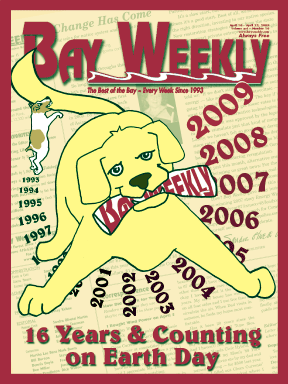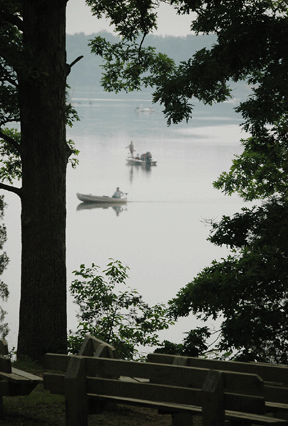
Volume XVII, Issue 16 - April 16 - April 22, 2009 |
 |
|
|
|
|
Along with the Good News
Comes the Bad
Along Chesapeake Bay, isn’t that always the way?
The pristine waters of Mattawoman Creek are at a critical stage due to the current development and growth already occurring throughout Charles County. This new highway, if approved, will slice right through the heart of the watershed that currently filters runoff and sediment from encroaching development.
–Scott Sewell, conservation director, Maryland Bass Federation,
in a letter to Maryland Secretary of Environment Shari Wilson
I guess one has no choice but to accept the bad with whatever good news pops up on the Chesapeake’s continually eroding environmental front. Once in a while Bay advocates are tossed a bone, but soon more trouble overwhelms whatever sweet flesh might have been on that bit of skeletal remains.
The other day brought both good and bad. I had hardly a moment to savor the news that the General Assembly had rejected the proposed $2.5 million in budget cuts to Maryland Department of Natural Resources’ Fisheries Service before the very next e-mail wiped the smile from my mug. The troubled Potomac’s tributary, Mattawoman Creek, was on the list of the 10 most endangered waterways of the environmental group American Rivers.
In the nearly 53 years since I arrived here, Bay restoration is a history of a step ahead (and rarely a giant step) and two steps back. How many more steps in the wrong direction can our Chesapeake endure?
Certainly, it was heartening to learn the General Assembly thwarted the attempt to slash $2.5 million from the Fisheries Service budget, much of the credit due to pressure from the Maryland Legislative Sportsmen’s Foundation. Not a penny was taken. Fishermen and environmentalists had had enough: Continued shrinking of the funding pool for the resource had to be stopped.
Make Way for Development
While we’ve saved big bucks for fisheries, we’re threatening a 27-mile creek that is a cornerstone of one of Chesapeake Country’s success stories. Mattawoman Creek is a gem, what with its thriving largemouth bass-spawning capacity and other fish life; its waterfowl and bald eagles; its treed watershed, rare and endangered plant life, scenery and serenity — including Smallwood State Park; and its well-earned billing as one of Maryland’s best and most convenient open-to-the public locales for introducing newcomers to fishing, camping and hiking.
Yet many in authority and with influence think the watershed could be better utilized as a $60 million Cross-County Connector, a four-lane, six-mile-long highway to serve development and growth in northern Charles County. Same old story: Cut more trees to make room for more vehicles on more roads and more development for more people.
Already, with the highway and development only in the planning stage, the 95-square-mile watershed is stressed. Trees are cut, fish-spawning areas shrink and over the long haul there’s less dissolved oxygen in the creek for aquatic life. A state report tells us that fish life is diminished as more than five percent of a watershed is covered with pavement and rooftops. The Mattawoman Creek watershed is already covered at near 10 percent. Implementation of the road and development projected is predicted to add another five percent. In all that’s about three times capacity.
Keep Your Fingers Crossed
In the larger theme of things, this relatively small watershed’s plight might seem insignificant. But hasn’t that been the pattern all along? We fail to grasp that enough baby steps make a giant step. At some point we must draw a line, and not in the shifting sands, but in hard cement. Time is running short.
Maryland Department of the Environment, we’re told, plans by June 1 to decide whether to approve permits for the county to build a highway, without which development will find a tough row to hoe. But, as many counties do, Charles put the cart before the horse, putting up some funding for sewer and water to service future development. Now the county is fighting hard not to lose its investment.
On the other side, Department of the Environment has at its asking the scientific resources of the Department of Natural Resources, which can be mighty testy about loss of wetlands, as well as fishing and hunting guides, nature and conservation groups and anti-sprawl advocates.
This is not a debate limited to Charles County, where there is considerable support for development and easing of traffic bottlenecks, and it goes beyond Maryland. It is regional, involving the entire Chesapeake Bay Watershed.
Keep your fingers crossed.
Enough said.

